This site is supported by our readers. We may earn a commission, at no cost to you, if you purchase through links.
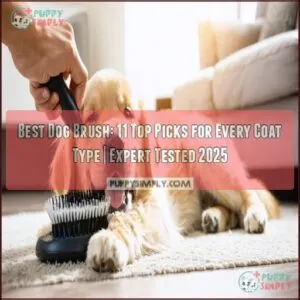
For short, smooth coats, a rubber grooming brush removes loose hair while boosting circulation. Long-haired breeds benefit from slicker brushes, like the Chris Christensen Big G, to tackle tangles and mats gently.
Double-coated dogs shed less with a deshedding tool such as the Maxpower Planet Pet Brush. Look for durable, ergonomic brushes that keep grooming comfortable for both you and your dog.
Regular brushing keeps their coat shiny and also strengthens your bond. The right brush can make grooming a breeze—your pup will thank you, and it’s a great way to boost their overall health.
Table Of Contents
- Key Takeaways
- Choosing Best Dog Brush
- Dog Coat Types Matter
- Top 11 Dog Brushes
- 1. Chris Christensen Mark VII Curved Slicker Brush
- 2. Chris Christensen Oval Pin Dog Brush
- 3. Chris Christensen Big G Dog Slicker Brush
- 4. Red Rubber Grooming Brush With Loop Handle
- 5. Dog Shampoo Brush for Grooming
- 6. Pet Grooming Rake Dematting Brush
- 7. Four Paws Magic Coat Dog Cat Brush
- 8. Maxpower Planet Pet Hair Brush
- 9. GoPets Deshedding Dematting Comb for Pets
- 10. Show Tech Slicker Brush for Dogs
- 11. King Kanine Self Cleaning Pet Brush
- Benefits of Regular Grooming
- Effective Brushing Techniques
- Frequently Asked Questions (FAQs)
- What’s the best kind of dog brush?
- What do groomers use to brush dogs?
- Which brush is best for dog hair?
- Which brush is best for dogs?
- What is rule #1 for grooming a dog?
- What is a good dog brush?
- What are the best dog brushes for shedding?
- How do I choose the best dog grooming brush?
- What is the best dog groomer oval brush?
- What is the best dog brush for a thick mane?
- Conclusion
Key Takeaways
- Match your dog’s coat type with the right brush; slicker brushes handle tangles, deshedding tools tackle loose fur, and bristle brushes suit smooth coats.
- Regular brushing reduces shedding, prevents painful mats, and promotes a healthy, shiny coat.
- Use ergonomic brushes with durable bristles to keep grooming comfortable for you and your dog.
- Grooming is more effective when you brush gently, use detangling sprays for knots, and maintain a consistent routine.
Choosing Best Dog Brush
You’ll need to match your dog’s coat type to the right brush style for effective grooming, whether you have a short-haired Dalmatian or a fluffy Husky.
Selecting a quality brush with the right bristle material and comfortable handle will make regular grooming sessions easier and more effective for both you and your furry friend, which is key to effective grooming.
Brush Style Considerations
When selecting a dog brush, style matters as much as functionality.
Consider bristle density and pin length based on your grooming goals. Slicker brushes with fine wires excel at detangling, while pin brushes reach deeper into thick coats.
Look for handle ergonomics that prevent hand fatigue during lengthy grooming sessions. Self-cleaning designs save time, and material quality guarantees durability.
Combo brushes offer versatility with two tools in one.
Coat Type Importance
Your dog’s coat type is the compass that guides your brush selection. Different dog coat types—whether short, long, or double—require specific tools for effective grooming.
Coat texture, seasonal shedding patterns, and breed standards all influence which brush will work best. For instance, a Husky with heavy seasonal shedding needs different care than a Poodle’s curly coat.
Consider grooming frequency and allergy concerns when making your choice. Regular brushing also supports preventing tartar buildup, which is an important aspect of overall dog care and preventing health issues.
Quality and Durability Factors
While coat type guides your brush choice, the construction determines how long it’ll serve you and your furry friend.
A quality dog brush pays for itself through years of Long-Term Use.
When evaluating brush durability and quality, consider:
- Material Strength: Stainless steel bristles resist bending or breaking
- Bristle Integrity: Properly secured bristles won’t fall out
- Handle Design: Ergonomic grips prevent hand fatigue
- Cleaning Ease: Self-cleaning mechanisms save time, which is a key factor in Long-Term brush maintenance and overall durability.
Dog Coat Types Matter
You’ll need to match your dog’s specific coat type with the right brush to prevent discomfort and guarantee effective grooming.
Whether your pup has a smooth, double, or long coat, using the appropriate tool makes all the difference between a frustrating session and a productive one that removes loose fur and prevents matting.
Smooth Coats and Brush Recommendations
Identifying the right brush for your smooth-coated friend makes all the difference in their grooming routine.
Dogs like Dalmatians, Boxers, and Beagles benefit from gentle bristle options that won’t irritate their sensitive skin.
A rubber curry brush or grooming glove use promotes coat oil distribution while effectively removing loose fur.
You can find a suitable brush there.
For bath prep brushing, soft bristle brushes work wonders on smooth coats, leaving your short-haired companion looking sleek and feeling comfortable.
Double Coats and Deshedding Tools
The challenge of managing a double coat demands specialized tools for effective grooming.
Your double-coated friend needs tools like the FURminator or Maxpower Planet Double Sided Undercoat Rake, which can reduce shedding by up to 90%.
For best results, pair these deshedding tools with slicker brushes and use the line brushing technique.
Don’t forget to follow up with a comb to catch any remaining undercoat.
Some owners find that ergonomic handle designs reduce hand fatigue, making the grooming process more efficient with the right grooming tools and techniques.
Long Coats and Detangling Brushes
For dogs with flowing locks, proper detangling brushes are essential to maintain coat health and prevent painful mats.
Your long-coated companion needs specialized tools that work through tangles without causing discomfort.
- Pin brushes glide through silky coats, minimizing breakage
- Slicker brushes with fine wires effectively remove mats
- Wide-toothed combs tackle stubborn tangles when used with detangling sprays
- Rotating rake tools reduce grooming frequency while maintaining coat quality
- Flexible-bristled brushes are best detanglers for breed-specific mat prevention
Consider purchasing a quality dog brush for best results to ensure your dog’s coat remains healthy and well-maintained, which is crucial for their overall coat health and to prevent painful mats.
Top 11 Dog Brushes
You’ll find the perfect grooming tool for your furry friend in our expert-tested lineup of top dog brushes for 2025.
We’ve carefully selected these 11 brushes based on their performance across different coat types, ensuring you can tackle everything from everyday maintenance to serious deshedding with confidence, using the perfect grooming tool.
1. Chris Christensen Mark VII Curved Slicker Brush
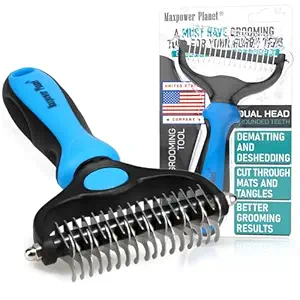
The Chris Christensen Mark VII Curved Slicker Brush sits at the top of our list for good reason.
It is handcrafted from lightweight beech wood with high-grade steel pins, this brush minimizes coat damage while the ergonomic handle reduces wrist strain during longer grooming sessions.
You’ll appreciate its ultra-soft cushion with a 1/4" foam base that makes brushing comfortable for your furry friend.
It’s particularly effective for medium to large breeds with medium to long coats, making quick work of tangles while being gentle on your dog’s skin, which is a key benefit of using the Chris Christensen Mark VII Curved Slicker Brush.
Best For: Medium to large dog breeds with medium to long coats, especially those needing tangle and mat removal.
- Lightweight beech wood handle reduces wrist strain.
- High-grade steel pins minimize coat damage.
- Ultra-soft foam cushion provides comfort during grooming.
- Not suitable for short-haired breeds or small dogs.
- Premium materials may make it more expensive than alternatives.
- Requires extra care to avoid bending the steel pins.
2. Chris Christensen Oval Pin Dog Brush
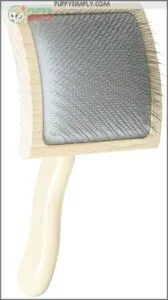
Luxury meets functionality in the Chris Christensen Oval Pin Dog Brush, crafted with German beechwood and polished stainless steel pins.
With 30% more pins than standard brushes, it glides effortlessly through delicate coats while reducing wrist strain thanks to its ergonomic handle. You’ll appreciate how the ground, polished pin tips prevent skin irritation during grooming sessions.
Available in five different styles to match specific coat types, this brush features a strategic air vent for flexibility. It’s particularly effective for fragile coats that require gentle but thorough maintenance, making it an excellent choice for dogs with sensitive skin, and its design ensures gentle maintenance while the polished pin tips prevent irritation.
Best For: Delicate and fragile coats, especially for dogs with sensitive skin requiring gentle grooming.
- 30% more pins for finer, more effective grooming.
- Ergonomic handle reduces wrist strain during use.
- Polished pin tips prevent skin irritation.
- May not be suitable for very thick or matted coats.
- Premium pricing compared to standard brushes.
- Limited to five styles, which might not cover all coat types.
3. Chris Christensen Big G Dog Slicker Brush
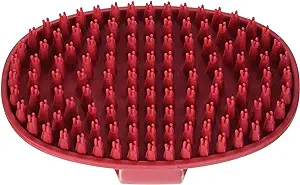
For those with dense, curly-coated breeds, the Big G Slicker Brush stands out from the pack.
This premium tool features remarkably long 27mm bent pins that penetrate deep into thick coats like Poodles and Doodle varieties.
You’ll appreciate how the cushioned pad retracts pins to gently capture tangles without hurting your pet.
With 30% more pins than competing brands and an ergonomic GroomGrip handle, you’ll cut brushing time in half while preventing hand fatigue.
It’s available in three sizes to match your dog’s needs, making grooming sessions more efficient and comfortable.
Best For: Owners of dense, curly-coated breeds like Poodles, Goldendoodles, and Labradoodles seeking an efficient tool for detangling and grooming.
- Long 27mm bent pins penetrate dense coats without hurting pets.
- Cuts brushing time in half with ergonomic handle and high pin density.
- Comes in three sizes, ensuring a fit for different dog sizes and grooming needs.
- Not designed for short-haired or thin-coated breeds.
- No warranty included, which may concern long-term users.
- Higher price point compared to standard grooming brushes.
4. Red Rubber Grooming Brush With Loop Handle

Bath time heroes come in many forms, but Le Salon Essentials’ Red Rubber Grooming Brush stands out with its practical loop handle design.
You’ll find this brush excels at removing loose hair from short-coated breeds while doubling as a shampoo distributor during baths. At $12.97, it’s an affordable addition to your grooming kit.
The flexible rubber construction makes it gentle on your pup’s skin and easy to clean after use. Remember not to use this on matted fur or tangled coats—it’s strictly for smooth operators who need regular maintenance.
These brushes are also beneficial for improving skin health by reducing irritation, making them a great tool for overall dog care and grooming kit essentials, and they can help with skin health.
Best For: Owners of short-coated breeds looking for an affordable and easy-to-use grooming brush that works well during bath time and for regular maintenance.
- Not suitable for matted or tangled coats
- Designed only for short-coated breeds
- Limited to basic grooming needs
- Affordable price at $12.97
- Doubles as a shampoo distributor during baths
- Gentle on the skin and easy to clean
5. Dog Shampoo Brush for Grooming
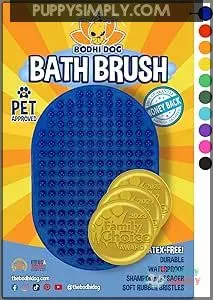
The rubber-tipped bath brush transforms grooming time into a soothing massage for your furry friend.
With soft tips that effectively remove dead skin and loose fur without pulling, this waterproof tool works on both wet and dry coats.
It’s especially ideal for short-haired breeds and pets with sensitive skin.
The natural, unrefined rubber design minimizes chemical exposure while enhancing shampoo lathering—saving you product and money.
Three-time winner of the Family Choice Awards, this brush holds onto fur during grooming, preventing messy cleanup.
Simply turn upside down, tap, and gently pull to remove collected hair, making it a practical tool for easy cleanup and a great way to reduce messy cleanup.
Best For: Pet owners with short-haired breeds looking for a gentle, eco-friendly grooming tool that doubles as a soothing massage brush.
- Soft rubber tips effectively remove dead skin and loose fur without pulling.
- Waterproof design suitable for both wet and dry coats.
- Minimizes shampoo usage and enhances lather for a deeper clean.
- Not suitable for long or thick-haired pets due to tangling risks.
- Specifically designed for short-haired breeds, limiting versatility.
- Rubber material may wear out with heavy or prolonged use.
6. Pet Grooming Rake Dematting Brush
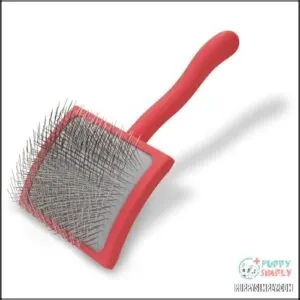
Frequently overlooked in grooming kits, the dual-sided Pet Grooming Rake Dematting Brush is a game-changer for thick-coated breeds.
With 9 teeth on one side and 17 on the other, this stainless steel tool tackles everything from stubborn mats to everyday shedding. The rounded teeth penetrate deep without irritating your dog’s skin, while the ergonomic handle with soft-grip guarantees comfortable grooming sessions.
It’s particularly effective for long-haired dogs and hard-to-reach areas like the neck and thighs.
Regular use improves circulation and prevents painful tangles that can lead to skin issues, making it a valuable tool for overall dog health.
Best For: Pet owners with long-haired or thick-coated breeds who need a reliable tool for dematting, thinning, and deshedding.
- Dual-sided design offers versatility for dematting and deshedding.
- Rounded teeth ensure safety while penetrating deep into the coat.
- Ergonomic handle reduces hand fatigue during grooming.
- Sharp blades require cautious use to avoid injury.
- Not suitable for use on pets with very short or fine coats.
- Needs regular cleaning and maintenance for durability.
7. Four Paws Magic Coat Dog Cat Brush
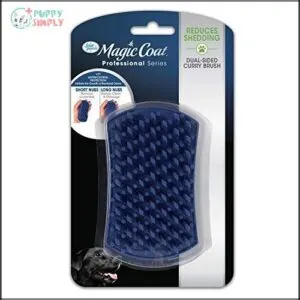
This double-sided silicone wonder serves both dogs and cats with short, curly, or wiry coats.
You’ll appreciate how it works wet or dry, making it perfect for bath time grooming. The flexible silicone nubs provide a gentle massage while stimulating natural oils for a healthier, shinier coat.
One side features longer nubs for skin cleansing while the other has shorter ones for loosening excess hair.
It’s specially treated to inhibit odors, and the comfort-flex design contours nicely to your pet’s body, creating a soothing experience they’ll actually enjoy with a healthier, shinier coat.
Best For: Pet owners with dogs or cats that have short, curly, or wiry coats looking for a versatile and gentle grooming tool.
- Works effectively for both wet and dry grooming.
- Stimulates natural oils for a healthier and shinier coat.
- Comfortable and soothing experience with a flexible silicone design.
- No information on durability or lifespan.
- Lacks maintenance or cleaning instructions.
- Limited to short, curly, or wiry coat types.
8. Maxpower Planet Pet Hair Brush
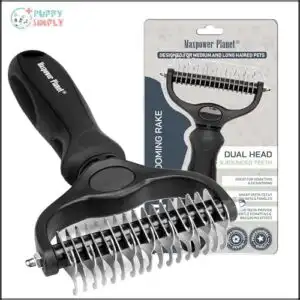
In the case of tackling thick fur and stubborn mats, the Maxpower Planet Pet Hair Brush stands out with its dual-sided design.
You’ll appreciate the versatility of its 9-teeth side for tackling mats and 17-teeth side for efficient deshedding.
The sharpened yet finely rounded stainless steel teeth work gently without irritating your pet’s skin.
With its non-slip rubber handle, you can comfortably remove up to 95% of dead hair in minutes.
Pet owners consistently report reduced shedding and happier pets who actually enjoy the grooming process.
It’s particularly effective for dogs with dense double coats.
Best For: Pet owners with dogs or cats that have thick fur or dense double coats and need a comfortable, effective grooming tool.
- Requires careful use to avoid skin irritation.
- Less effective on severe matting without patience and time.
- Best used outdoors to manage fur cleanup for heavy shedders.
- Dual-sided design efficiently handles mats and deshedding.
- Removes up to 95% of loose hair and reduces shedding significantly.
- Gentle, skin-friendly teeth ensure pet comfort during grooming.
9. GoPets Deshedding Dematting Comb for Pets
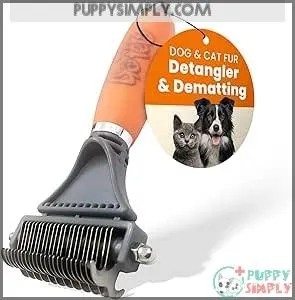
In the context of versatile grooming tools, the GoPets Deshedding Dematting Comb stands out with its clever dual-sided design.
The 9-teeth side tackles stubborn mats and tangles, while the 17-teeth side excels at thinning and deshedding.
You’ll appreciate the thoughtful design features like stainless steel blades with rounded ends that protect your pet’s sensitive skin.
The ergonomic handle with non-slip silicone gel prevents hand fatigue during longer grooming sessions.
This multi-functional tool works wonderfully on both cats and dogs, effectively reducing dander and cutting down on hair around your home.
Best For: Pet owners looking for a versatile grooming tool that effectively removes mats, tangles, and loose fur in both cats and dogs.
- Dual-sided design for tackling mats, tangles, and deshedding.
- Rounded stainless steel blades protect sensitive skin.
- Ergonomic, non-slip handle reduces hand fatigue.
- May require practice to use effectively on thick coats.
- Not ideal for pets with extremely short or very thin fur.
- Larger size might be less comfortable for small hands.
10. Show Tech Slicker Brush for Dogs
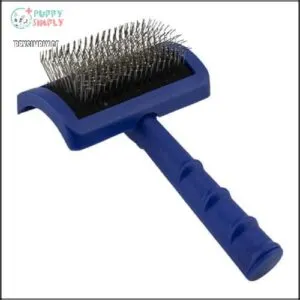
Show Tech’s selection of slicker brushes tackles even the most stubborn tangles with precision.
Their "Tuffer Than Tangles" model features long, angled pins that penetrate deep into thick coats, while the Smooth Touch option provides gentle grooming with fine, closely spaced pins.
You’ll appreciate the ergonomic handles that prevent hand fatigue during longer grooming sessions.
The Universal Soft Slicker’s curved design reaches sensitive areas easily, and its anti-slip grip stays secure even when wet.
These professional-quality brushes are ideal for curly-coated breeds like poodles and doodles, delivering show-quality results for both professionals and pet owners.
Best For: Pet owners and professional groomers handling dogs with curly, thick, or dense coats, especially breeds like poodles and doodles.
- Effective at removing mats, tangles, and dense undercoats.
- Ergonomic handle prevents hand fatigue during use.
- Curved and padded designs ensure gentle brushing on sensitive areas.
- Long pins may take time for some pets to adjust to.
- Specific models may not be ideal for short or smooth coats.
- Lightweight plastic design may feel less durable for heavy use.
11. King Kanine Self Cleaning Pet Brush
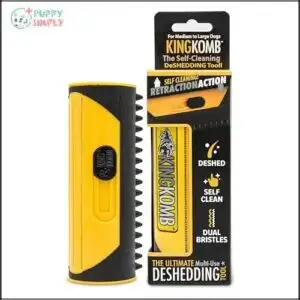
The King Kanine Self Cleaning Pet Brush offers impressive versatility for multiple pets in your home.
With its self-cleaning retraction feature, you’ll easily remove accumulated fur with just a button press.
The 51 rubberized bristles gently tackle undercoat and stubborn tangles while promoting a healthier, shinier coat.
It’s particularly effective for medium and large breeds, and the comfortable grip makes grooming sessions more enjoyable for both you and your pet.
Regular use reduces shedding and also improves circulation and eliminates allergy-triggering danders from your furry friend’s coat.
Best For: Pet owners with medium to large dogs, cats, or horses looking for an easy, effective grooming tool to reduce shedding and keep coats shiny.
- Self-cleaning retraction feature simplifies fur removal.
- Gentle rubber bristles reduce tangles and promote coat health.
- Comfortable grip makes grooming less tiring.
- Not ideal for small breeds or fine-coated pets.
- Requires regular use for best results.
- May not remove heavy matting effectively.
Benefits of Regular Grooming
You’ll help your dog stay healthier and happier with regular brushing, which prevents painful mats while reducing shedding around your home.
Your consistent grooming routine also strengthens your bond with your pet, as those few minutes of focused attention create valuable connection time that most dogs come to enjoy.
Preventing Tangles and Mats
Tackling tangles before they become stubborn mats is your best defense against painful grooming sessions.
Daily brushing with the right dog brush for matted hair keeps coat problems at bay. Use detangling sprays when you encounter minor knots, focusing on breed-specific trouble spots like behind ears and armpits.
Remember that professional grooming every 6-8 weeks complements your home care routine, especially for breeds prone to tangles.
Pet owners should be aware of potential grooming exploitation to guarantee their pet’s safety and understand the importance of regular grooming.
Promoting Healthy Coat and Skin
Regular brushing does more than just prevent tangles—it’s essential for dog skin and coat health.
When you brush your dog, you’re stimulating skin cells, improving circulation, and distributing natural oils throughout their coat.
This simple routine helps prevent irritation, reduces allergies, and creates a natural shine.
It’s like giving your pup a mini-massage that maintains coat health while letting you check for any unusual bumps or skin issues, which is essential for dog skin and overall coat health.
Reducing Shedding and Allergens
Shedding season doesn’t have to turn your home into a fur factory.
Regular brushing with a deshedding tool for dogs removes loose hair before it lands on furniture, reducing household allergens by up to 90%.
With just 10 minutes of daily grooming, you’ll notice less dander, fewer sneezes, and cleaner air.
The best brush for shedding isn’t just a tool—it’s your first line of defense in allergen control.
Enhancing Bonding and Trust With Dogs
Through regular grooming sessions, you’re building more than just a beautiful coat—you’re creating a foundation of trust with your dog.
When approached properly, brushing becomes quality bonding time rather than a chore.
Here’s how grooming strengthens your relationship:
- Positive reinforcement with treats rewards cooperation during brushing
- Gentle handling teaches your dog to enjoy physical contact
- Consistent routine builds confidence and security
Reading your pet’s body language guarantees comfort throughout the process.
Effective Brushing Techniques
You’ll get the most from your dog brush when you master proper grooming techniques that work for your pet’s specific coat type.
Even the best brush won’t perform well if you’re not using the right motion, pressure, and approach for sensitive areas like the belly, face, and paws.
Brushing Sensitive Areas With Care
Sensitivity demands special attention when brushing your dog’s delicate areas.
Use gentle techniques around the face, ears, belly, and paws where skin is thinner. Control pressure and switch to softer brush bristles to avoid irritation on sensitive spots.
Watch for signs of discomfort and offer positive reinforcement. For dogs with sensitive skin, consider specialized dog brushes designed with rounded tips and gentle flexibility.
Introducing Brushing to Puppies
When brushing a puppy, start with a gentle introduction using a soft, puppy-safe brush.
Keep sessions short and use positive reinforcement like treats or praise to make grooming enjoyable.
Avoid overwhelming them; instead, frame brushing as a fun bonding activity.
This builds trust and sets the stage for lifelong dog care, ensuring grooming feels safe and comfortable.
Using Conditioners and Grooming Sprays
Spray application is a game-changer for dog grooming.
Use detangling sprays before brushing to ease knots, while conditioners boost coat hydration and shine.
For sensitive pups, choose products that reduce allergens.
Apply diluted sprays after using dog shampoo, especially for harder-to-manage coats.
Many owners find grooming sprays effective for regular care.
These tools make coat maintenance smoother and keep your furry friend happy and tangle-free, which is a key aspect of regular care.
Avoiding Common Brushing Mistakes and Injuries
To avoid injuries while brushing, focus on gentle and effective techniques.
Using the wrong tools or excessive force can cause skin irritation or worsen matted fur.
Try these dog grooming tips:
- Use a dog brush designed for your pet’s coat type.
- Avoid brushing sensitive areas without extra care.
- Train uncooperative pets slowly to build comfort.
These steps protect your dog’s health and are crucial for effective grooming techniques.
Frequently Asked Questions (FAQs)
What’s the best kind of dog brush?
The best dog brush depends on your pup’s coat type.
For short hair, try a bristle brush; for long or double coats, go with a slicker brush.
Deshedding tools work wonders for heavy shedders!
What do groomers use to brush dogs?
Groomers often use tools like slicker brushes for detangling, pin brushes for gentle grooming, and de-shedding tools to tackle undercoat shedding.
They choose brushes based on the dog’s coat type and grooming needs.
Which brush is best for dog hair?
Choosing the right dog brush depends on your dog’s coat.
For detangling, use a slicker brush.
Deshedding tools tackle heavy shedding, while bristle brushes suit short-haired dogs.
Match the brush to your pup’s needs, this is the key to effective brushing.
Which brush is best for dogs?
The best brush for your dog depends on their coat type.
Pin brushes work for long coats, slicker brushes handle tangles, and bristle brushes suit smooth coats.
Grooming gloves are great for short-haired pups!
What is rule #1 for grooming a dog?
Rule #1 for grooming a dog is to make certain they’re comfortable.
Start slowly, use gentle strokes, and keep the process positive with treats or praise.
A calm dog makes grooming easier and stress-free for both of you.
What is a good dog brush?
A dog brush is like a magic wand for grooming.
A slicker brush works wonders for detangling, while a bristle or pin brush handles shedding.
Pick one based on your dog’s coat type for best results.
What are the best dog brushes for shedding?
The FURminator Undercoat deShedding Tool stands out for tackling heavy shedding while being gentle on skin.
For versatility, try the Bissell Furget It or SleekEZ Grooming Tool, both great for removing loose fur effortlessly.
How do I choose the best dog grooming brush?
Find a brush that suits your pup’s coat type—pin brushes work for long, thick coats, while bristle or curry brushes fit short hair.
Prioritize gentle grooming to avoid tugging and keep their skin healthy.
What is the best dog groomer oval brush?
The Chris Christensen Oval Dog Brush stands out for its stainless steel pins and ergonomic design, making grooming smooth and efficient.
It’s versatile, suitable for various coat types, and built to last with a beechwood handle.
What is the best dog brush for a thick mane?
For a thick mane, try a pin brush or a heavy-duty slicker brush.
They detangle effectively, reach the undercoat, and remove loose fur.
Opt for rounded tips to stay gentle on your dog’s skin.
Conclusion
Selecting the best dog brush isn’t just about convenience—it’s like finding the perfect tool to keep your dog healthy and happy.
Whether your pup has a smooth coat, a double coat, or long fur, the right brush prevents tangles, reduces shedding, and boosts skin health.
Plus, regular grooming strengthens your bond.
From slicker brushes to deshedding tools, you’ve got plenty of options to make brushing a breeze, and your dog will thank you with wagging tails!

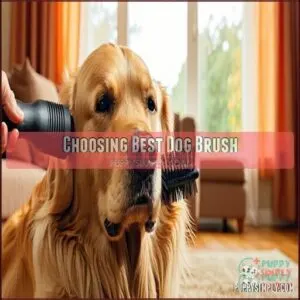

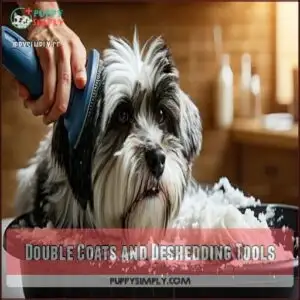
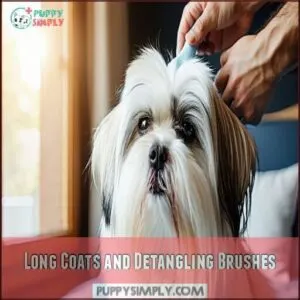


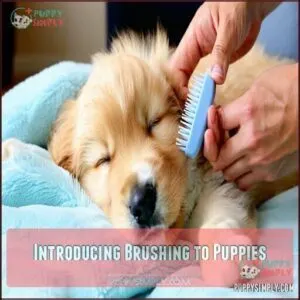
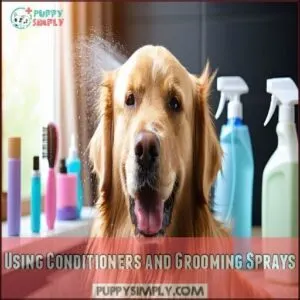
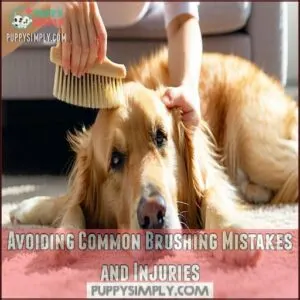



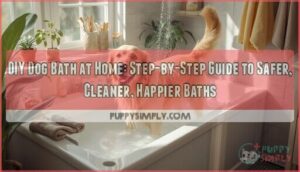
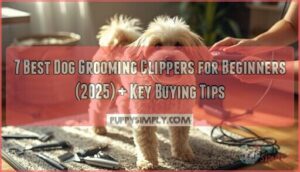
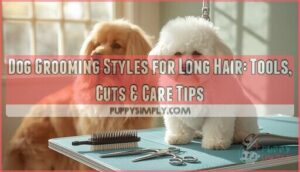
xinhulian
April 16, 2025 at 12:24 PM
good